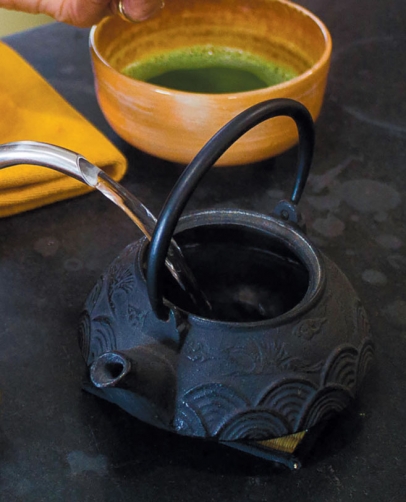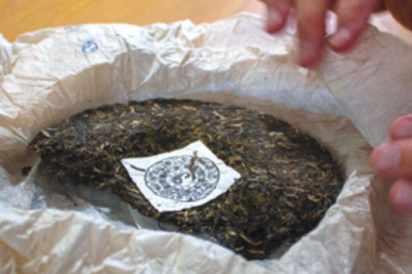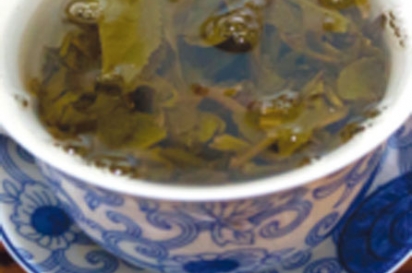Experience This Gift: Plum Blossom Tea
Just off the bustling main street of Suttons Bay there is a shop that offers a refuge from the busy shuffle of this popular tourist destination. Soothing music plays quietly and water trickles down a small rock fountain. The colors and the fragrance instantly calm me. I have come to partake of the tea with owners Michelle and Doug Racich, and I feel that I have entered a haven of peace and serenity.
Michelle greets me warmly and shows me around. Shelves lining the walls hold attractive silver boxes of tea. There are sets of teapots and cups everywhere, some quite delicate and others very earthen and sturdy. A map behind the door tracks visitors from around the world, and provides reference for those who do not know the tea countries.
When we get to the high counter, Michelle introduces me to her husband, Doug. They opened Plum Blossom Tea Company a year ago to share the benefits of tea with their community. Michelle's decades of study of Aikido and Tae Kwon Do had led her to studying the art of tea, and the discipline of the various tea ceremonies. A tea shop was the perfect extension of her work as a Shiatsu bodywork professional and practitioner of Oriental medicine.
Many visitors come to Plum Blossom Tea, Michelle says, because they are well traveled and have had matcha and other forms of tea in different parts of the world. Just as many come in out of curiosity and find they enjoy the process of learning about that many types of teas.
Michelle: Customers often end up sitting here for quite a while, as a respite. They are surprised when they just want to sit here just a little longer. They say to me, "I need to do this."
Once customers get a taste of matcha, or other teas, and like it, Michelle helps them select their own tea ware and assists them in planning and preparing a small tea preparation area in their homes. There are small mats that can be used in offices and other places of work, so that matcha can be enjoyed throughout the day and in many different situations.
Michelle: All you really need is a bowl, a wooden whisk and the matcha of your choice. You can, and most people do, go on to select other items to enrich your tea service, but the whole point is to be quiet and simple and have a little time apart from a busy life to enjoy tea. Our matcha bowls are made by Northport Pottery, to our specifications. They have little divots in them to hold the powdered tea, and the base of them is made for sitting on the gong fu tray.
Michelle then tells me about the other type of Japanese tea ceremony. It is much more formal and is performed sitting on a mat on the floor. When she performs this type of ceremony, she uses the large mat on the floor in her bodywork office. If people have trouble getting down on the floor, she furnishes chairs.
Michelle: Because that ceremony happens on a mat, it has to be very tidy. The conversation is very scripted, and a very specific dialog takes place between the host and the first guest, and then with the first guest and the rest of the guests. It is considered more Zen like, and is an equalizer–everyone has to bow low to get into the tea room, and then is the same height. In the days of the Samurai, the swords were left outside. Now that is done very symbolically, with a fan. When you are receiving tea, there is a formal arrangement of flowers, and a scroll, and all the tea ware is appropriate for the season. One must only talk about what is happening now–it is all about this moment. For instance, you can talk about the weather, as it is happening now.
Michelle begins to prepare the table and mat for our next type of tea, and ritual. Doug directs my attention to the large rounds of pressed tea, wrapped in paper on some of the shelves. These are disks of pu-erh, a highly specialized type of Chinese tea. We go to the counter where he has a pu-erh already open. He peels open the paper to reveal a dark and dense-looking collection of tea leaves.
Doug: Pu-erh is compressed tea that is then composted, or fermented. There are two kinds of pu-erh. One is raw, and one is aged. Some rounds of this tea are let to age for a very long time. Others are served within a few years. Pu-erh has been around for thousands of years, but, back in the 1970s, someone accidentally let their tea sit too long, and it became ripe. They pressed it into a cake and it turned out the people loved it. People speculate on these pu-erh, buy thousands of dollars worth of cakes and let them age, as they will be worth even more in the coming years.
The next hour is spent in convivial yet peaceful enjoyment of each other, and the tea. We are having what Michelle calls "a loose and wet Chinese tea." Doug and I sit back down at the table. The magic mat is always wet, and Michelle pours and pours and wets and readies all the vessels on the mat. I wonder aloud about why there is not water all over the table and the floor, and she shows me the tube that goes down under the table from the tray into a lovely earthen carafe, also made by Northport Pottery. The carafe collects the many cups of water that wash over the tray as we participate in the Chinese part of the evening of tea drinking.
She takes about 4 tablespoons of a young raw pu-erh and places it in her gai wan.
Hers is blue and white, and looks like a fine porcelain bowl with a lid. She pours hot water over it and then pours that water out, like she is rinsing it, through a sieve and into a glass pitcher. She pours this rinse over all the serve ware on the tray, as if warming and rinsing them too. Then she prepares the first pour. She pours hot water over the mass in the gai wan, and lets the tea leaves steep for just a couple of minutes, and then she carefully pours the brew into the pitcher through the sieve. She holds up the beautiful golden liquid for me to see, swirling it around a bit. Then, using the pitcher, she fills the small cups called cha hai, tiny clay cylinders with no handles. She places a tiny matching bowl upside down over the cha hai, like a lid. Then, using a special hand hold that she teaches me, she turns the cha hai over onto a small wooden tray in front of me. She repeats these gestures for Doug, and then for herself. She lifts the cylinder, and all the hot tea releases into the little bowl. She takes the warm cylinder to her nose and indicates that it is time to smell the tea.
I copy what she and Doug are doing and smell the hot vessel. It has an earthy and almost floral perfume, and feels lovely and warm in my hand. I am reminded of sniffing the cork of a good bottle of wine.
Then, we all drink our tea from the tiny bowls. It tastes soft and fresh and reminds me of black tea I have had before. But it is more subtle, and a little sweet. I observe that Doug is slurping a little with this drink, too.
Michelle: If you slurp and bring air into your mouth with the tea, it aerates it. And if you close your mouth and then exhale through your nose, you can get the impression of the tea, and it gives you a sense of its qualities... it is like a wine tasting.
Doug: With each steep, as you go through the many pours, the leaves of the pu-erh start to open more and more. The taste changes from pour to pour. You end up enjoying many different levels of taste and tea, and you end up with pours that you like better than others.
I notice this as we go through the cycle. On the fifth pour, there was a pungent and almost bitter flavor to the tea. I recognized that flavor from black teas I have let steep too long in the past. Then, on the next pour, the tea was so delicious, so succulent that I could not believe it was from the exact same leaves in the gai wan. I loved it and savored the liquid in the tiny bowl, wanting this pour to last a little longer. I felt that I was already able to discern some of the differences in taste and the properties of this pu-erh. By the tenth, and final, pour, I felt that I had experienced the full range of this tea.
Doug: Most of the caffeine in a pu-erh is released in the first two pours. You can have the first two pours in the morning, and then come back later in the day and use the same leaves and do a few more pours, and you don't have to worry about how the caffeine will affect you.
While we were working our way through the many pours, I learned more about both Michelle and Doug. They were living in Chicago, raising three young children. Doug had a busy dental practice but was also working on his art. They came to an art show in Northern Michigan and just knew this was where they wanted to be. Doug sold his practice, and they moved north before their kids started high school. Doug now is a full-time artist, specializing in color theory and painting with watercolor and egg tempura. Michelle has a thriving practice. But they both knew they wanted to bring the world of tea to this place they love so much.
Michelle: Tea of this kind does not grow well in the United States. Plus, tea has lineage that must be observed. Some of the precious yellow tea is matriarchal, passed from mother to daughter for many, many generations. You cannot just start that in a new place. But you can bring this art form to a new place, and make it fresh and new, while honoring the ancient practices. You can honor all the hands that have touched the leaf, all the care and knowledge that has come down through the ages to make this the very best it can be.
Doug: We did not want to offer a tea room that was just like a coffee shop. There is no wifi here. We do want to provide something to our community. Tea has the same values that sustain the local food community here. Take coffee as an example–it is not grown here, but it can be roasted here. Tea is the same. We make it local with the pottery, the view, the knowledge we have to share. We have taken a very traditional beverage and studied it and gone back to its roots and learned about it, and now we can share it and help others integrate both this art form and this healing drink into their lives.
Michelle: One thing that is really important to us is that this is a consumable gift. We offer an experience that you can take home with you, or that you can give to someone else.
Doug: Our kids tell us not to get them gifts that sit around . . . they don't want stuff. Matt is a perfect example: He wants us to donate to a charity in his name, or plant a tree. Our girls want lives rich with experience. That is exactly what tea, and ceremony, are. They are gifts. Gifts that have a bigger story.
Our time together done, we hug and say our goodbyes like we are old friends. I feel like I have been given a gift. The intentionality of this place, creating a space that is energetically and symbolically apart, gave to me a time of relaxation and self care, all while enjoying the company of two won derful people, and having a deeply satisfying conversation. Experience this gift!
IF YOU GO:
Plum Blossom Tea Company
PlumBlossomTea.com
106 Adams St., Suttons Bay
Hours: Wednesday & Thursday 1–5 PM,
Friday & Saturday 10 AM–5 PM
231-238-3999
Japanese Tea Ceremony
We are going to do a very informal Japanese tea ceremony first. Michelle invites Doug and me to take our seats on the low stools around the table in the middle of the room.
Michelle sits behind the table, where she can easily reach the electric teapot that keeps water at a constant temperature. She is wearing a beautiful kimono, with long sleeves that she gracefully manages during all the movements she must perform in her role as host of the tea ceremony. On the table in front of her is a wooden gong fu tray, set with a striking pottery bowl, called a chawan. Next to it is a canister of beautiful green matcha tea. Michelle uses a long wooden scoop with a very small end, called a chasaku, to scoop the matcha into the bowl. She then pours hot water over the green powder, and uses a chasen, or wooden whisk, to whip the green powder into a tea. It becomes frothy and bubbly and fragrant. She prepares one for Doug and one for me.
Michelle: Tea is a ritual that creates a space apart from regular life, a place to slow down, be intentional and quieted, and treat yourself and perhaps others to a healing cup of earthy herb. Customers can stop in and sit in the peaceful space, and partake of a cup of many different types of tea, learning the tastes and attributes of the teas offered. Tea culture, in Asia and even in Europe, is about sitting still, being present, and that combined with the health benefits makes tea so ideal, and so nourishing.
I see Doug pick up his bowl with both hands wrapped around it.
Doug: Drink this all in two or three big gulps. Really drink it like you mean it.
He demonstrates, and when he is almost done, I hear him slurp the last little bit. Michelle tells me that is how it is done, and I try it. I hold the warm bowl in both my hands, bring it to my lips and then take three big gulps. The frothy green liquid is comforting and soothing to my mouth and throat as it goes down, easy and delicious. The fragrance of the tea is there in the aftertaste. Then I slurp up the last little bit.
All About Matcha
Matcha is considered a special type of healing tea. There are claims that it can help prevent or cure cancer, lower cholesterol, increase physical endurance and enhance concentration. It is antiviral and antibacterial. This type of tea contains an abundant amount of the catechin, EGCg (epigallocatechin gallate), which is proven to provide potent cancer-fighting properties. A study conducted at the University of Colorado in 2003 confirmed that one cup of matcha green tea has 137 times the amount of EGCg compared to a conventional cup of green tea. EGCg and other catechins found in green tea also fight free radicals throughout the body.
Michelle: Matcha is vegetal. This is the bright green leaf of tea, shade grown and harvested carefully at its peak. Just before harvest, the garden of tea plants is covered with a dark cloth, to keep the chlorophyll in the leaf at just the perfect level. This is a very high grade of matcha, full but not heavy, just smooth as it goes down into the belly. Highest grades are the first picked, and contain the strongest properties. You are ingesting the whole green plant, full of healing antioxidants and the special type of catechins that are only found in matcha.
Ceremony-grade matcha is steamed, dried and then, traditionally, milled between two large stones. Culinary-grade is machine milled and does not retain the bright green color, but instead looks more olive green. Doug shows me a photo on his phone, from a recent trip they took to the Northwest Tea Festival in Seattle. I can see the leaves going into a stainless steel contraption, a mill, from the top, and at the bottom, in a ring around the opening, a pile of bright green matcha.
Doug: The way the body processes the caffeine in matcha is totally different than with the caffeine in coffee. Zen Buddhist monks discovered long ago that matcha could aid in the long meditative sitting that they do. They could stay alert and relaxed at the same time. They had more stamina. Even the Japanese warriors found it could assist them in battle.
Michelle: The health benefits derive from its unique chemistry, how it affects your body. All teas are basically the same plant. Tea is a varietal–the terroir, how it is grown and how it is processed are all very important to the properties the tea will impart. Green is the healthiest, because it is the least processed.
Krystn Madrine is a writer, photographer and food stylist from Northern Michigan. Her work focuses on the matrix of food, family, story and sustainability. Her food blog can be found at KrystnMadrine.com/krystns-kitchen.






